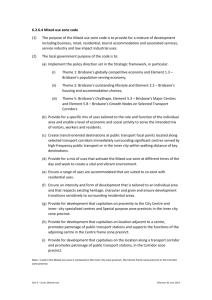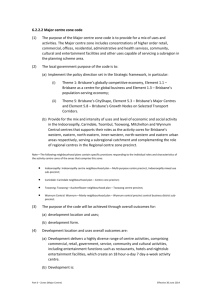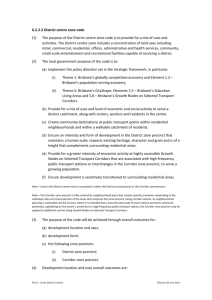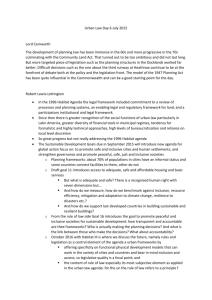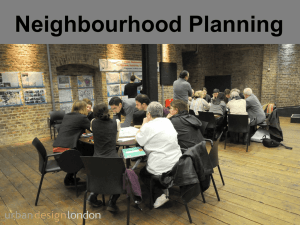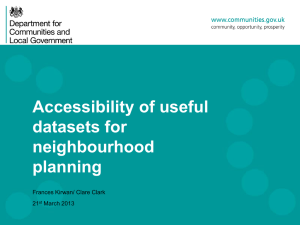Albion neighbourhood plan code (Word - 271kb)
advertisement
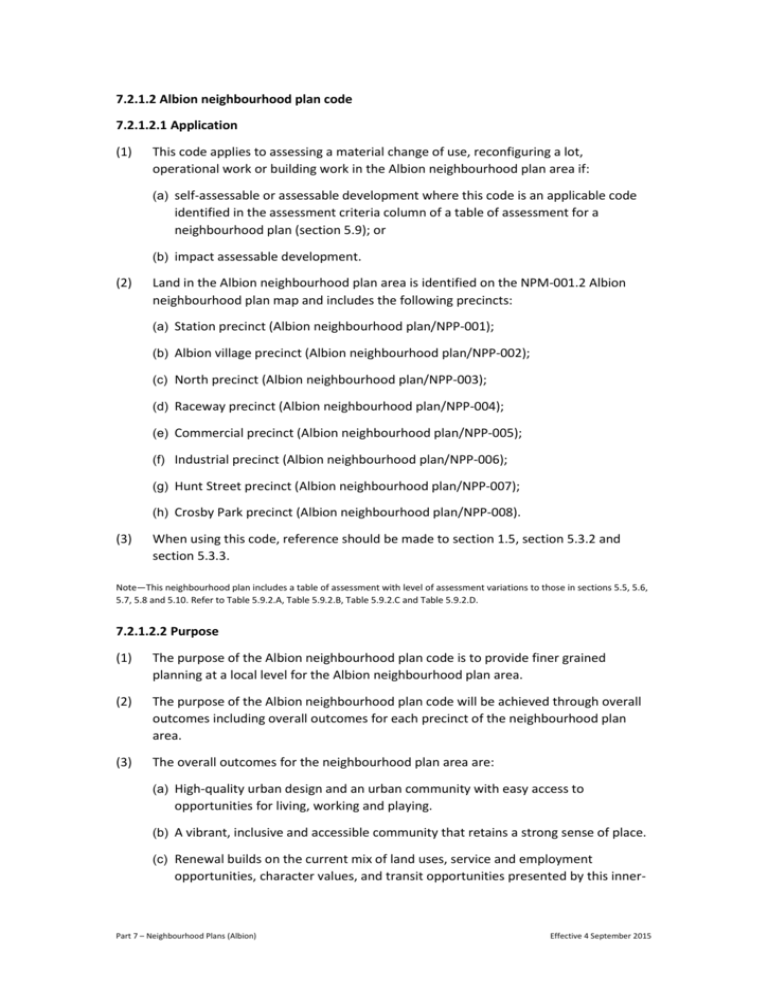
7.2.1.2 Albion neighbourhood plan code 7.2.1.2.1 Application (1) This code applies to assessing a material change of use, reconfiguring a lot, operational work or building work in the Albion neighbourhood plan area if: (a) self-assessable or assessable development where this code is an applicable code identified in the assessment criteria column of a table of assessment for a neighbourhood plan (section 5.9); or (b) impact assessable development. (2) Land in the Albion neighbourhood plan area is identified on the NPM-001.2 Albion neighbourhood plan map and includes the following precincts: (a) Station precinct (Albion neighbourhood plan/NPP-001); (b) Albion village precinct (Albion neighbourhood plan/NPP-002); (c) North precinct (Albion neighbourhood plan/NPP-003); (d) Raceway precinct (Albion neighbourhood plan/NPP-004); (e) Commercial precinct (Albion neighbourhood plan/NPP-005); (f) Industrial precinct (Albion neighbourhood plan/NPP-006); (g) Hunt Street precinct (Albion neighbourhood plan/NPP-007); (h) Crosby Park precinct (Albion neighbourhood plan/NPP-008). (3) When using this code, reference should be made to section 1.5, section 5.3.2 and section 5.3.3. Note—This neighbourhood plan includes a table of assessment with level of assessment variations to those in sections 5.5, 5.6, 5.7, 5.8 and 5.10. Refer to Table 5.9.2.A, Table 5.9.2.B, Table 5.9.2.C and Table 5.9.2.D. 7.2.1.2.2 Purpose (1) The purpose of the Albion neighbourhood plan code is to provide finer grained planning at a local level for the Albion neighbourhood plan area. (2) The purpose of the Albion neighbourhood plan code will be achieved through overall outcomes including overall outcomes for each precinct of the neighbourhood plan area. (3) The overall outcomes for the neighbourhood plan area are: (a) High-quality urban design and an urban community with easy access to opportunities for living, working and playing. (b) A vibrant, inclusive and accessible community that retains a strong sense of place. (c) Renewal builds on the current mix of land uses, service and employment opportunities, character values, and transit opportunities presented by this inner- Part 7 – Neighbourhood Plans (Albion) Effective 4 September 2015 city location, to provide a greater and more diverse range of employment, residential uses, entertainment, recreation opportunities and services. (d) Higher density development includes a mix of uses where appropriate, provides dwelling choices such as affordable housing and is of a high-quality design. (e) Integrated land use and transport planning close to the railway station and bus routes increases use of public transport, reduces private vehicle use, improves access to the train station and bus stops, promotes intermodal connection and is designed to mitigate impacts of the railway. (f) Parks service the existing and future sporting and informal recreation needs of the community. (g) High-quality and accessible urban recreation areas contribute to landscape amenity, including through redevelopment that improves public access to Breakfast Creek and the Brisbane River, and improvements to Yowoggera and Cameron Rocks parks. (h) Community access to the waterfront is provided at Council-owned land in Argyle Street as part of any redevelopment after the depot ceases operation. (i) Important character values are retained and enhanced through maintaining key views to the City Centre, Brisbane River, Breakfast Creek and Mt Coot-tha, and conserving views to local landmarks such as Bartley’s Hill and Eildon Hill. (j) The movement system is improved and facilitates pedestrian and cyclist movements to activity areas, public transport, parks, Breakfast Creek and the Brisbane River. (k) Once the flour mill redevelopment is substantially occupied, mixed use, high density, residential development is accommodated in the medium term in the future mixed use development area as shown in Figure a. (l) Redevelopment improves road linkages in the south of the neighbourhood plan area as identified in Figure a. (m) Development is of a height, scale and form which is consistent with the amenity and character, community expectations and infrastructure assumptions intended for the relevant precinct, sub-precinct or site and is only developed at a greater heights, scale and form where there is both a community need and an economic need for the development. (4) Station precinct (Albion neighbourhood plan/NPP-001) overall outcomes are: (a) Revitalisation for a mix of higher density residential and offices capitalises on proximity to, and provides a high level of accessibility to, the railway station and Albion village. (b) Development complements, extends and consolidates the suburban functions provided in Albion Village, and may include a supermarket. (c) Affordable housing is encouraged. Part 7 – Neighbourhood Plans (Albion) Effective 4 September 2015 (d) Development improves connections for pedestrians and cyclists between the railway station, Albion Village and surrounding residential and employment areas. (e) Albion Road is designed to promote pedestrian movement while continuing to accommodate some limited vehicle movements. (f) Buildings are of a human scale along major pedestrian routes and integrate with existing heritage buildings and have active frontages. (g) An urban common of a minimum 2,000m2 is provided. (h) Buildings adjacent to the railway station and rail corridor do not compromise future volumetric development over the rail corridor and manage the adverse amenity impacts of the railway through the design and placement of appropriate uses. (i) Development does not compromise the streetscape hierarchy or access over the rail corridor or to adjacent precincts. (j) New development is mixed use and ensures local amenity and public views are retained to the CBD, Brisbane River, Breakfast Creek and Mt Coot-tha. Views are also conserved to local landmarks such as Bartley's Hill and Eildon Hill. (k) There are visual links to the railway station and adjoining area with the station being usually prominent with its own identify and visibility in the public realm. (5) Albion village precinct (Albion neighbourhood plan/NPP-002) overall outcomes are: (a) Albion village continues as the core retail, food and drink outlets and entertainment precinct in the neighbourhood plan area. (b) Infill development occurs between character and heritage buildings and complements their heritage values and setting. (c) Development fronting Sandgate Road continues the pedestrian environment and the human scale of development along the street with higher building forms set back from the street front and positioned behind lower building forms. (6) North precinct (Albion neighbourhood plan/NPP-003) overall outcomes are: (a) Intensification of high-quality residential development occurs only after the concrete batching plant operation ceases, to avoid adverse amenity impacts on new residential development. (b) Expansion of industry and warehouse activities does not occur, although minor improvements and new, short-term, non-residential uses in existing buildings may occur. Such proposals shall demonstrate that the use will not detrimentally affect the amenity of existing or future surrounding residential uses. (c) An urban common of approximately 4,000m2 is provided in Burdett Street, by closure of part of Burdett Street and 10% land contribution from surrounding lots. Steep land along the eastern boundary of the precinct is also dedicated as park. (d) Development improves pedestrian connections from Lapraik Street along Lever Street to the railway station. Part 7 – Neighbourhood Plans (Albion) Effective 4 September 2015 (e) Development is designed to sensitively integrate with existing adjoining dwellings. (f) Building heights ensure views are retained from Lapraik Street to Eildon Hill, Mt Coot-tha and the CBD. (7) Raceway precinct (Albion neighbourhood plan/NPP-004) overall outcomes are: (a) Relocation of the Albion Park raceway facility allows redevelopment for medium density residential development and increased business activity. (b) If the raceway is repositioned, a park with public road frontage and a minimum area of 5,000m2 is provided to the Council. The future park is located at the northern end of Amy Street as indicated in Figure a or elsewhere within the development if a publicly accessible plaza in private ownership is proposed in this location instead. (c) If the raceway is repositioned redevelopment mitigates adverse impacts on adjacent residential uses. (d) If the raceway relocates and the site redeveloped to include residential purposes, an additional urban common is provided and consolidated with Crosby Park. (e) Amy Street is mostly residential in nature with some limited entertainment or convenience uses at ground storey. (f) Development improves vehicular, pedestrian and cyclist linkages to and through the precinct. (8) Commercial precinct (Albion neighbourhood plan/NPP-005) overall outcomes are: (a) Well-designed offices and low impact industry uses, which do not have detrimental impacts on nearby residential areas, transition or provide a buffer between residential areas and low impact industry uses. (b) Areas bordering Crosby Park include office uses that support the sports focus of the park, such as physiotherapy. (9) Industrial precinct (Albion neighbourhood plan/NPP-006) overall outcomes are: (a) Medium impact industries and complementary small-scale offices are accommodated. (b) Residential development is not provided. (10) Hunt Street precinct (Albion neighbourhood plan/NPP-007) overall outcomes are: (a) Medium to high density residential development is accommodated. (b) Commercial development only fronts Kingsford Smith Drive. (c) Heights of development minimise impacts on nearby residential areas and maintain key view corridors. (11) Crosby Park precinct (Albion neighbourhood plan/NPP-008) overall outcomes are: (a) Crosby Park continues as a public park servicing the sporting and informal recreation needs of the local and wider community, with sporting uses Part 7 – Neighbourhood Plans (Albion) Effective 4 September 2015 contributing to the character and significance of the park, such as the Brothers Rugby city-wide facilities. (b) Any further expansion of the nationally significant Queensland Cricket facilities involves State Government support and any significant expansion results in community benefit. (c) Park works are informed by a Council-prepared park management plan and explore opportunities to consolidate new uses with existing facilities. 7.2.1.2.3 Assessment criteria The following table identifies the assessment criteria for self-assessable and assessable development. Table 7.2.1.2.3.A—Criteria for self-assessable and assessable development Performance outcomes Acceptable outcomes Section A—If for self-assessable development If a centre activity not involving building work in the Station precinct (Albion neighbourhood plan/NPP-001) or the Albion village precinct (Albion neighbourhood plan/NPP-002) PO1 AO1 Development must mitigate impacts of the railway. Development for residential uses does not front the railway. PO2 AO2 Development reinforces an active frontage along Sandgate Road. Development for retail, food and drink outlet and other uses that reinforce an active frontage is located along Sandgate Road. PO3 AO3 Development ensures that the location of uses within the precinct is in keeping with the separate themes of the adjoining streets. Development locates office or residential uses along Anstey Street and Birbeck Street. Section B—If for assessable development General PO4 AO4 Development reinforces an active frontage along Sandgate Road. Development locates retail, food and drink outlet and other uses that reinforce an active frontage along Sandgate Road. PO5 AO5 Development ensures that the location of uses within the precinct is in keeping with the separate themes of the adjoining streets. Development locates office or residential uses along Anstey Street and Birkbeck Street. PO6 AO6 Development is of a height, scale and form Development complies with the number of Part 7 – Neighbourhood Plans (Albion) Effective 4 September 2015 that achieves the intended outcome for the precinct, improves the amenity of the neighbourhood plan area, contributes to a cohesive streetscape and built form character and is: (a) consistent with the anticipated density and assumed infrastructure demand; (b) aligned to community expectations about the number of storeys to be built; storeys and building height in Table 7.2.1.2.3.B. Note—Neighbourhood plans will mostly specify a maximum number of storeys where zone outcomes have been varied in relation to building height. Some neighbourhood plans may also specify height in metres. Development must comply with both parameters where maximum number of storeys and height in metres are specified. Refer to Figure a for further detail on maximum number of storeys. (c) proportionate to and commensurate with the utility of the site area and frontage width; (d) designed so as not to cause a significant and undue adverse amenity impact to adjoining development; (e) sited to enable existing and future buildings to be well separated from each other and to not prejudice the development of an adjoining site. Note—Development that exceeds the intended number of storeys or building height can place disproportionate pressure on the transport network, public space or community facilities in particular. Note—Development that is over-scaled for its site can result in an undesirable dominance of vehicle access, parking and manoeuvring areas that significantly reduce streetscape character and amenity. PO7 AO7 Development proposals must demonstrate integration with adjacent land in terms of infrastructure, recreation space and pedestrian, cyclist and vehicular movement. No acceptable outcome is prescribed. Note—This can be demonstrated through incorporating the relevant principles of the Structure planning planning scheme policy. PO8 AO8.1 Development scale, height and design must: Development has a building height and design that retains key views in the following precincts: (a) not result in significant loss of a view corridor; (b) reduce building bulk; (c) be graduated to be in character with the potential height of adjoining buildings; (d) be mixed to ensure visual variation; (e) other than in the Station precinct (Albion Part 7 – Neighbourhood Plans (Albion) (a) Station precinct (Albion neighbourhood plan/NPP-001) – maximum building height to be informed by a view analysis; (b) North precinct (Albion neighbourhood plan/NPP-003) – views to and from Bartley’s Hill, the City Centre, Eildon Hill, Effective 4 September 2015 neighbourhood plan/NPP-001) and Albion village precinct, (Albion neighbourhood plan/NPP-002) be in keeping with the medium or medium to high density nature of the zone or precinct; (f) development in the Station precinct (Albion neighbourhood plan/NPP-001) must also: Mt Coot-tha and the river; (c) Raceway precinct (Albion neighbourhood plan/NPP-004) and Hunt Street precinct (Albion neighbourhood plan/NPP-007) – views to/from Newstead Park rotunda and park, Palma Rosa House, Bartley’s Hill and the City Centre. (g) be in keeping with the precinct’s role as a transit oriented development; Note—This may be demonstrated by a view analysis. (h) be mixed; Development contributes to a mix of building heights and massing within the relevant precinct. (i) ensure local amenity and public view corridors are retained to the City Centre, Brisbane River, Breakfast Creek and Mt Coot-tha and that views are conserved to local landmarks such as Bartley’s Hill and Eildon Hill; AO8.2 Note—Building scale is managed through maximum building heights and the design requirements in the applicable codes. No gross floor area limitation is prescribed. (j) ensure the railway station is visually prominent with its own identity and visibility in the public realm; (k) create visual links to the railway station and adjoining areas; (l) development in the North precinct (Albion neighbourhood plan/NPP-003) ensures that views are retained from Lapraik Street to Eildon Hill, Mt Coot-tha and the City Centre. PO9 AO9 Development provides increased residential densities located in close proximity to Albion railway station in the North precinct (Albion neighbourhood plan/NPP-003) and Station precinct (Albion neighbourhood plan/NPP001). Development provides a minimum density of 120 dwellings per hectare in the Station precinct (Albion neighbourhood plan/NPP001) and in the North precinct (Albion neighbourhood plan/NPP-003). If in the Station precinct (Albion neighbourhood plan/NPP-001) PO10 AO10 Development conserves the heritage values of the precinct. Development ensures heritage and character structures are retained and incorporated into the design of any redevelopment scheme for the railway station. PO11 AO11 Development mitigates the impacts of the railway. Development for residential uses does not front the railway. Part 7 – Neighbourhood Plans (Albion) Effective 4 September 2015 If in the Albion village precinct (Albion neighbourhood plan/NPP-002) PO12 AO12.1 Development must complement and be generally aligned with existing heritage buildings. Development provides a front setback that is aligned with the average setback of adjoining heritage buildings. AO12.2 Development is built to the side boundaries at ground level, where not adjoining residential uses at ground storey. PO13 AO13 Development reinforces an active frontage along Sandgate Road. Development of retail, food and drink outlet, and other uses that reinforce an active frontage, are located along Sandgate Road. PO14 AO14 Development ensures that the location of uses within the precinct is in keeping with the separate themes of the adjoining streets. Development locates office or residential uses along Anstey Street and Birkbeck Street. If in the North precinct (Albion neighbourhood plan/NPP-003) PO15 AO15 Development for residential uses ensures that the amenity of residents is not affected by the operation of the existing concrete batching plant. Development does not occur within the precinct until the adjacent concrete batching plant operation ceases. PO16 AO16.1 Development has a building footprint and design that reduces bulk and amenity impacts on adjoining residential development. Development provides a maximum site cover of 60%. PO17 AO17 Development for non-residential uses is short term, minor and demonstrates that the use will not detrimentally affect the amenity of existing or future surrounding residential uses. Development for non-residential uses: AO16.2 Development provides a minimum setback, of 3.5m to the site boundary of existing residential uses. (a) is in operation for no longer than 5 years; (b) is located within existing buildings; (c) involves no (or only minor) building work; (d) is designed to internalise potential noise and pollutant sources in buildings and/or away from the site boundaries. Part 7 – Neighbourhood Plans (Albion) Effective 4 September 2015 If in the Raceway precinct (Albion neighbourhood plan/NPP-004) PO18 AO18 Development: No acceptable outcome is prescribed. (a) minimises land use conflict; (b) integrates with surrounding land uses through improved pedestrian and vehicular connections; (c) minimises adverse impacts on the amenity of existing residential properties; (d) provides for the long-term integration of the precinct into the surrounding area; (e) maintains a buffer between industrial and residential land uses; (f) protects views and residential amenity for nearby residential areas; (g) complements and allows access to Crosby Park; (h) includes a local road network, the design of which minimises the introduction of non-residential traffic into residential areas. PO19 AO19 Development must contribute to the pedestrian amenity along Amy Street. Development retains and incorporates mature trees located along Amy Street into future development. If in the Industrial precinct (Albion neighbourhood plan/NPP-006) PO20 AO20 Development of industrial uses mitigates impacts on surrounding existing and potential incompatible uses. Development of industrial uses is not located within 20m of: (a) a sensitive use; or (b) an existing office except where the office is ancillary to another use; or (c) the Commercial precinct (Albion neighbourhood plan/NPP-005). If in the Crosby Park precinct (Albion neighbourhood plan/NPP-008) PO21 AO21 Development ensures that the total building footprint of Queensland Cricket, including any expansion, is no greater than 7,500m2. No acceptable outcome is prescribed. Note—Subject to a structure planning process in order to Part 7 – Neighbourhood Plans (Albion) Effective 4 September 2015 balance the national significance of the facility with the local recreation needs of the community and the landscape amenity it provides. Structure plans are to be prepared in accordance with the Structure planning planning scheme policy. PO22 AO22 Development proposals for expansion of sporting uses resulting in an area greater than 500m2 of gross floor area within the park provide community benefit and enhance public use of the park. Development proposals greater than 500m2 of gross floor area maximise community benefit through initiatives such as: (a) removing existing buildings and consolidating the uses within new buildings; (b) improving useability of the park by the general public; (c) providing shared facilities for use by the general community or with other park uses; (d) entering into an agreement for shared use of facilities with another sporting club. Table 7.2.1.2.3.B—Maximum building height Development Building height (number of storeys) If in the Albion village precinct (Albion neighbourhood plan/NPP-002) Development of a site located fronting Birkbeck Street 2 Development of a site located in the balance As per Figure a of NPP-002 If in the North precinct (Albion neighbourhood plan/NPP-003) Development of a site located fronting Dover Street 3 Development of a site located in the balance 6 storeys or RL 33 AHD, whichever is the of North precinct (Albion neighbourhood lesser plan/NPP-003) If in the Raceway precinct (Albion neighbourhood plan/NPP-004) Development of a site located fronting Cooksley Street 2 Development of a site located in the block bounded by Agnes Street, Amy Street, Yulestar Street and Kingsford Smith Drive 7 Development of a site located in the balance 5 of Raceway precinct (Albion neighbourhood plan/NPP-004) Part 7 – Neighbourhood Plans (Albion) Effective 4 September 2015 If in the Commercial precinct (Albion neighbourhood plan/NPP-005) Development of a site located fronting Fox Street, Elliot Street or Collingwood Street 3 Development of a site located in the balance 5 of Commercial precinct (Albion neighbourhood plan/NPP-005) If in the Hunt Street precinct (Albion neighbourhood plan/NPP-007) Development of a site located in the balance 5 of Hunt Street precinct (Albion neighbourhood plan/NPP-007) Development of a site located fronting Kingsford Smith Drive, between Agnes Street and Hunt Street 7 Development of a site located in the block bounded by Hunt Street, Cooksley Street, Yulestar Street and Kingsford Smith Drive 8 Note—Where Table 7.2.1.2.3.B is silent, building heights are in accordance with Figure a. Note—Maximum building height is determined by view analysis in the Station precinct (Albion neighbourhood plan/NPP-001) and may impact development height in the North precinct (Albion neighbourhood plan/NPP-003), Raceway precinct (Albion neighbourhood plan/NPP-004) and Hunt Street precinct (Albion neighbourhood plan/NPP-007). Part 7 – Neighbourhood Plans (Albion) Effective 4 September 2015 View the high resolution of Figure a–Albion neighbourhood plan area (PDF file size is 227Kb) Part 7 – Neighbourhood Plans (Albion) Effective 4 September 2015


